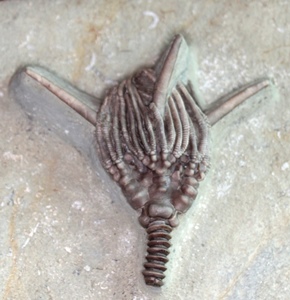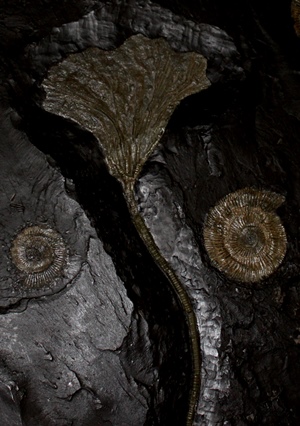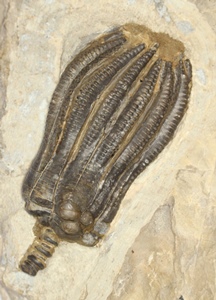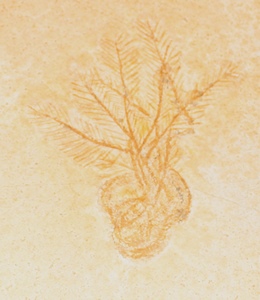Crinoids: rare fossils.
1. Presentation
Crinoids are exclusively marine animals, well known in fossil form, but many species of which still live today.
No species are known in river or lake environments, either in the fossil record or today. They form the class "Crinoidea", a subdivision of the phylum Echinodermata, which also includes:
- Cystoids, Carpoids, Blastoids, Homalozoa, Eocrinoids, Ophiocistioids, Edrioasteroids, Helicoplacoids (extinct classes) as well as Echinoids (Sea urchins), Ophiuroids (Brittle stars), Asteroids (Starfish) and Holothurians (Sea cucumbers).
The first known Crinoids are dated to the Ordovician, at - 470 million years. All other classes of the Echinoderms phylum appear more or less at the same time, in the Cambrian for the oldest.

Dorycrinus gouldi from the Carboniferous of Crawfordsville in the United States
2. Morphology
Crinoids owe their common name of "Sea Lily" to their plant-like morphology. The name Crinoid comes from the Greek "krinon = lily" and "eidos = form".
Crinoids are generally composed of a stem (or peduncle) and a crown. The stem, more or less long, can reach several meters with a root allowing it to attach itself to the seabed or to another support for non-sedentary species. At the end of this stem is a calyx equipped with a variable number of long, flexible arms, sometimes themselves branched. These arms are equipped with pinnules (small filaments). The "calyx + arm" assembly forms the crown of the Crinoid.
The stems have an articulated calcareous skeleton composed of numerous ossicles (entroces) of circular or pentagonal shape with a central canal. Cutting the stem is not fatal for the Crinoid if it manages to reattach itself to a new support. Echinoderms in general have a strong capacity for regeneration and can easily reconstitute a lost arm, for example.
The stem is often the part of the Crinoids that fossilizes best. The preservation of a complete crown or even a complete specimen therefore remains uncommon. These echinoderms constitute particularly aesthetic fossils when the crown is preserved. See the page of fossil Crinoids for sale on our site. These animals have a pentaradial symmetry (of order 5) as for the majority of Echinoderms. Of approximately 650 species of Crinoids recorded still living today, the Comatulas represent the vast majority

Codiacrinus schultzei du dévonien de Bundenbach en Allemagne.
3.Lifestyle
Most fossil crinoids lived attached to the seabed or to floating trunks and drifted with the currents by their stems. The Comatulas are particular crinoids that do not have a stem and attach themselves to the seabed by cirri at the base of their calyx and thanks to which they can move while others live in open water and can swim and attach themselves as they please. They filter the water with their arms and feed on plankton. The majority of current crinoids are Comatulas, but as far as the fossil record is concerned, specimens with stems are much more numerous. They lived in colonies, sometimes very numerous, in the deep sea. For this reason, it is common to find associated specimens, sometimes even of different species. The crown provides shelter to many small animals (shrimp, brittle stars, gastropods). In the fossil record, fossilized brittle stars can sometimes be found in the crown of the crinoid, as in those from the famous Carboniferous deposits of Crawfordsville (Indiana - USA) or Gilmore City (Iowa - USA), of which you will find excellent specimens for sale on our site.

Eretmocrinus associated with other Carboniferous species

Some genera were distinguished by a particular lifestyle, such as the Scyphocrinites of the Late Silurian, the Cyrtocrinus of the Middle Jurassic, or the Uintacrinus and Marsupites of the Late Cretaceous, which were pelagic. The Scyphocrinites, for example, had a float at the end of their stem that allowed them to drift with the currents. Their fossils are well known because they can be found in large quantities in certain Moroccan Silurian deposits, and they are among the crinoids most often offered for sale. Furthermore, the Uintacrinus and Marsupites consisted of only a spherical, bulbous crown, thanks to which they moved freely in the water column.
Seirocrinus subangularis from the Lower Jurassic of Holzmaden in Germany
On peut également citer les Seirocrinus du Jurassique inférieur, bien connu du Lagerstätte Allemand de Holzmaden ou encore les Traumatocrinus du Trias supérieur de la province de Guizhou au sud-ouest de la Chine. Ces Crinoïdes vivaient attachés à des morceaux de bois flottants, il est d'ailleurs courant de trouver le fossile complet encore fixé à son support. Des pièces fossiles extraordinaires de ces Crinoïdes sont connues comme par exemple une colonie entière de plusieurs dizaines d'individus accrochés à un seul et unique tronc d’arbre.
Despite everything, the vast majority of fossil crinoids were sedentary and lived attached to the seabed in sometimes immense colonies. Some deposits are very famous for the large quantity and quality of the crinoids they have delivered. We can cite the Lagerstätte of Crawfordville in Indiana with its Echinoderms from the Lower Mississippian (Carboniferous). This deposit alone has delivered 60 different species of all sizes and shapes! Platycrinus, Cyathocrinus, Macrocrinus or even Dorycrinus with its large protruding spines at the level of the crown are only a few of the genera known from this locality.
Of the same age, the crinoids of Gilmore City in Iowa are also very diverse and very well preserved. Several fossils from this deposit are also for sale on our site, such as Aorocrinus, Eretmocrinus, Cercidocrinus or Dichocrinus.
In Germany, we know the Bundenbach deposit with its schists having preserved a very diverse and very well-preserved fossil fauna from the Devonian. More than 20 species have been recorded there, including Imitatocrinus, Triacrinus, Rhadinocrinus or Codiacrinus for example. In the Upper German and French Muschelkalk, we only know the species Encrinus liliiformis, with its circular entroques and which can have a stem reaching 1.5 meters with a crown exceeding 10 centimeters. We naturally offer specimens of Encrinus liliiformis for sale.
In the Lower Muschelkalk of Central Europe, the genus Dadocrinus is known, small in size and with a very fine morphology, which can be found in plates grouping together very numerous specimens. We can also cite Carnallicrinus or other species of the genus Encrinus.


Encrinus liliiformis from the Triassic of Alverdissen in Germany
Detail of a chalice
In Australia, the Permian Jimbacrinus are the best known and are often found in large numbers on plates. Although the crowns are generally very well preserved, they are often separated from their stems, and a specimen with a connected stem and crown remains rarer. The crowns of these crinoids are particularly aesthetic and appreciated by collectors. Anechocrinus, Occiducrinus, Stomiocrinus, and Dichocrinus are also known (among others) from the Australian Permian, but they are much less common.
In the Moscow region of Russia, the Carboniferous is well represented, particularly the Mississippian (Lower Carboniferous). Several quarries exploit rocks from this period and have yielded abundant but often fragmentary fauna. Nearly 50 species of crinoids have been described there. Among many other genera, we can cite Allosocrinus, Synyphocrinus, Moscovicrinus, Rhodocrinites, Paracrocrinus, Litocrinus or Ophiurocrinus. Crinoids are also known from the Pennsylvanian (Upper Carboniferous) of the Moscow Basin, but the fauna there is less diverse.
From Vaucluse (southeastern France), we have obtained particularly well-preserved fossils from the Burdigalian (Lower Miocene), such as the very numerous sea urchins of the genus Tripneustes or the bivalves of the genus Chlamys, but sedentary crinoids and comatulas are also known. These echinoderms can sometimes be found for sale at fossil fairs, but they remain relatively rare.

Jimbacrinus bostocki from the Permian of Australia
From the island of Timor (Indonesia) is known a Permian age fauna from the Sonnebait Formation very rich in Crinoids and composed of many endemic genera. Among these, we can find Paracatillocrinus, Timorocidaris, Timorocrinus, Delocrinus, Monobrachiocrinus or even Neoplatycrinus. These are systematically fragmentary and it is the extremely diverse calyxes that make all the charm of this Echinoderm fauna also composed of many Blastoid genera. You will find examples of these Crinoids and Blastoids for sale on our site.

As for Feather Stars, they are only known from the Jurassic period. It is believed that these crinoids adapted their lifestyle to escape predators, particularly sea urchins. The best-known sites for fossil Feather Stars are the Tithonian (Upper Jurassic) Lagerstätten of Solnhofen in Germany or the Cenomanian (Upper Cretaceous) of Hakel in Lebanon. In France, they are known from the Cenomanian of Ain or the Callovian (Middle Jurassic) of Ardèche, for example, not to mention the Burdigalian of Vaucluse mentioned above.
The examples cited above are by no means an exhaustive list, and many other genera and species of Crinoids are known from many localities throughout the world.
Fossil crinoids therefore formed a much more numerous and diversified fauna than current species, which, in addition to their particular aesthetic, contributes to giving them a place of choice among fossil enthusiasts.








